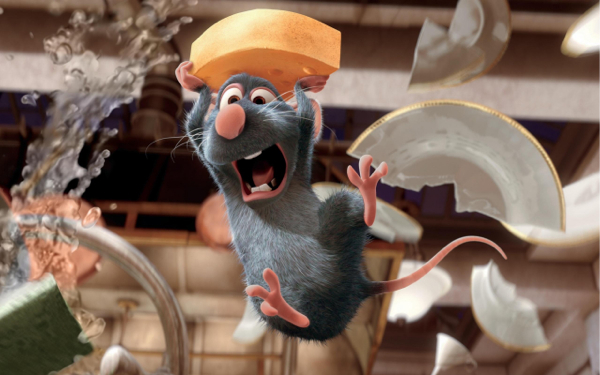Movie review by Greg Carlson
A major improvement over the disappointing “Cars,” Pixar’s “Ratatouille” is a delightful movie buoyed by top-flight animation, gorgeous design, and confident storytelling. Despite the obvious challenges of marketing a movie dealing with a rat who yearns to be a gourmet chef, “Ratatouille” will please even the most demanding animation fans with its rich palette of colors and flavors. Director Brad Bird, whose movies “The Incredibles” and “The Iron Giant” have marked him as one of the finest practitioners of feature-length animation, equals or betters his earlier work, and “Ratatouille” already seems destined for both critical and commercial accolades.
Pixar movies have regularly drawn from the Disney model that values a particularly difficult to achieve level of quality, and many of their stories feature central characters who aspire to greatness in a given field. In “Ratatouille,” a gifted rodent named Remy (Patton Oswalt) uses his highly developed sense of smell to distinguish between good food and bad. Initially, Remy’s skill is employed mainly to separate regular garbage from rat poison, but the rat hones his gift after being inspired by a television show featuring the recently deceased master chef Auguste Gusteau (Brad Garrett), a gourmand who lived by the motto “Anyone can cook.”
Since the death of its namesake, Gusteau’s restaurant has lost its prominence and luster, as new boss Skinner (Ian Holm) devotes more time to cashing in on a line of Gusteau frozen dinners than he does to culinary excellence. One evening, Remy completes a soup started by garbage boy Linguini (Lou Romano), a clumsy naïf with zero cooking skill. The dish is a smash hit, and before too long, the rat and the human have worked out a system that allows Remy to prepare food by offering direction from underneath Linguini’s toque. Linguini’s rise in popularity does not go unnoticed by the suspicious Skinner nor by the pretty Colette (Janeane Garofalo), who also happens to be the toughest chef in Gusteau’s kitchen.
Bird took over “Ratatouille” from Jan Pinkava during production, but there is no evidence of behind-the-scenes strife. Instead, the film is an absolute feast for the eyes, presenting more evidence of the steadily developing art of computer animation. A credit at the end of the movie boasts that no motion capture was used in the production of “Ratatouille,” and the statement is clearly a major point of pride for the animators who deliver one dazzling series of images after another. The level of detail is tremendously impressive, and the hustle and bustle of a busy restaurant kitchen, especially the process of cooking itself, is rendered in tones that are sumptuous, savory, and rich.
“Ratatouille” succeeds on many levels, and much credit must be given to Bird for astutely avoiding the shopworn clichés that mar the majority of contemporary animated features. “Ratatouille” has plenty of squirm-inducing shots of swarming rats, but there are few gags that rely on bodily functions. Additionally, the film adroitly resists the temptation to pepper the action with references to popular culture. This almost instantly imbues the proceedings with a timelessness that will surely age better than the vast majority of “Ratatouille’s” competition. “Ratatouille” will be challenging for its youngest viewers, but like certain cheeses and wines, it will be even better when those kids have grown old enough to appreciate it.
